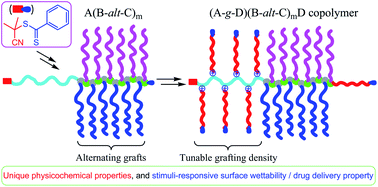a Jiangsu Key Laboratory of Advanced Functional Polymer Design and Application, Department of Polymer Science and Engineering, College of Chemistry, Chemical Engineering and Materials Science, Soochow University, Suzhou 215123, China
Polym. Chem. 2014, 5, 4679-4692
The synthesis and properties of novel (A-g-D)(B-alt-C)mD-type heterografted toothbrush-like copolymers are described. The target copolymers comprised three types of building blocks, involving a terminal comb-like block with a quaternization bridging poly(N,N-dimethylaminoethyl methacrylate) (PDMA, A) substrate and D grafts, a middle comb-like block with a poly(styrene-alt-maleimide) backbone and alternating PEG (B) and PCL (C) grafts, and a terminal D segment involving poly(N-isopropylacrylamide) (PNIPAM), poly(methyl methacrylate) (PMMA), polystyrene (PSt) and poly(methyl acrylate) (PMA). The combination of quaternization and RAFT processes allowed for the controlled synthesis of the target copolymers with a precise microstructure and tunable composition and grafting density. With the changes in macromolecular architecture, chemical composition and grafting density, toothbrush-like copolymers were liable to exhibit different physicochemical properties such as chain relaxation, melting, crystallization and self-assembly behavior. The introduction of chemical heterogeneity into non-responsive toothbrush-like copolymers could endow polymer films with notable thermo-dependent wettability due to accelerated surface penetration and reconstruction. Meanwhile, the drug release properties of PNIPAM-based aggregates were significantly affected by temperature, additives and end groups, revealing their potential as promising controlled delivery vehicles. In addition to developing a general approach towards the construction of sequence-defined toothbrush-like copolymers with multicomponent grafts and variable grafting densities, our study further extended their potential applications in stimuli-sensitive surfaces and biomedical materials via changing the compatibility and supramolecular interactions.

链接:
//pubs.rsc.org/en/content/articlelanding/2014/py/c4py00332b#!divAbstract